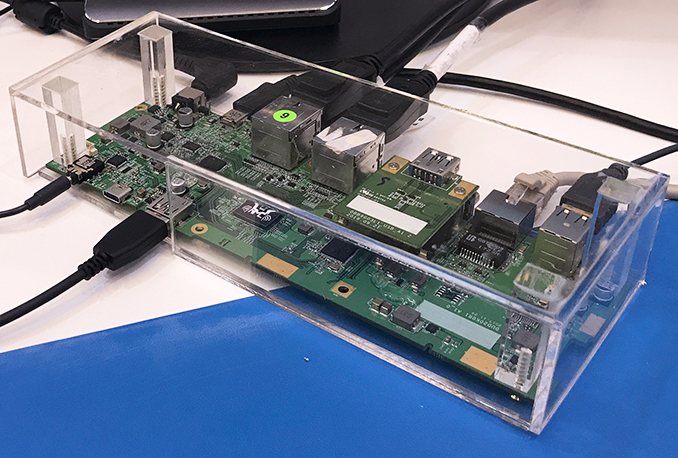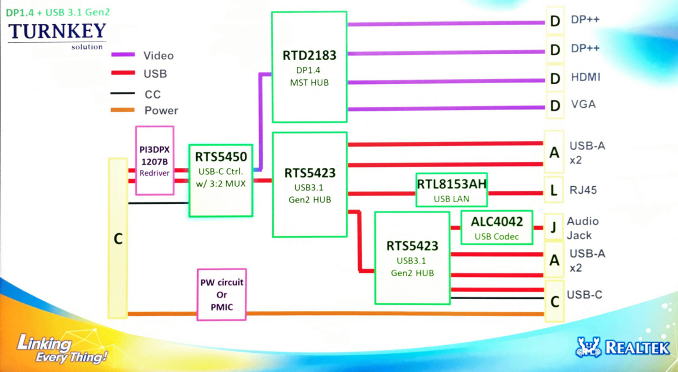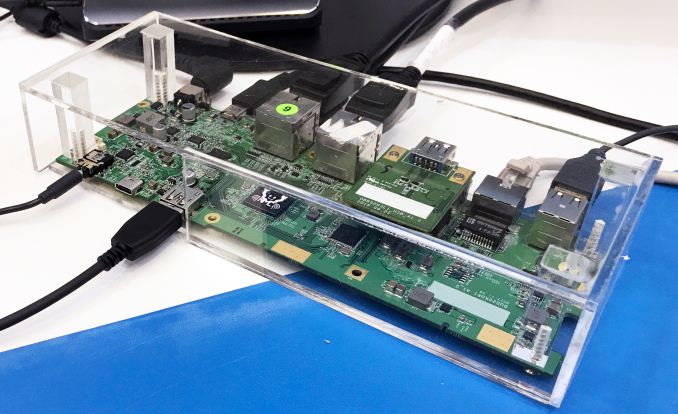Realtek Demonstrates a USB 3.1 G2 Type-C Dock Platform: An All-in-One Solution
by Anton Shilov on June 18, 2018 2:00 PM EST- Posted in
- Peripherals
- Trade Shows
- Realtek
- USB-C
- USB-C Hub
- Computex 2018

Realtek demonstrated a prototype of a USB 3.1 Gen 2 docking station that relies entirely on its own chips and features regular connectors, including USB Type-A, DisplayPort, HDMI, D-Sub, GbE, and audio.
USB Type-C is gaining popularity rather rapidly among notebook makers and there are a number of non-Apple laptops that feature only these connectors. Meanwhile, such laptops need docking stations to gain compatibility with regular USB Type-A, Gigabit Ethernet, display outputs and so on. Such devices are available, but are not always cheap because makers of hubs have to develop these products themselves and use chips from various suppliers. By contrast, Realtek’s turnkey USB 3.1 Gen 2 hub is based on chips that come exclusively from the company and the whole design is production ready, meaning no R&D investments from actual manufacturers.
Realtek’s turnkey USB 3.1 Gen 2 (10 Gb/s) hub relies on the firm’s RTS5423, RTS5450, RTD2183, RTL8153AH, ALC4042, and the PI3DPX 1207B chips. The hub features four USB Type-A connectors, a USB Type-C header, two DisplayPort 1.4 outputs, an HDMI, a D-Sub, an 3.5-mm TRRS audio jack, and a GbE port.
Realtek naturally does not indicate pricing of actual solutions based on its reference design because they depend on materials used and actual configuration of connectors. Today sophisticated USB-C docking solutions start at €109/$127, so hopefully Realtek’s turnkey dock will enable makers to bring the price of such products a bit down.
| Want to keep up to date with all of our Computex 2018 Coverage? | ||||||
 Laptops |
 Hardware |
 Chips |
||||
| Follow AnandTech's breaking news here! | ||||||












23 Comments
View All Comments
HStewart - Monday, June 18, 2018 - link
No matter what Thunderbolt 3 is significantly better than USB\-C Gen 2 - in fact it actually a super set of USB-C Gen 2 - It handles video better and once the controller on drives go better - it going to significantly better for storage. It also can handle external PCIe video cards.Alexvrb - Monday, June 18, 2018 - link
I really hate proprietary standards, but you're right. USB has fallen behind, and for all it's improvements USB-C has become a cluster of features that a port may or may not support. A lot of that is due to legacy baggage. Rather than replacing USB entirely, I wish they had went with a complimentary "everything you need for a dock" industry standard port.Something with PCIe, USB, audio, LAN, DP/HDMI, and enough juice to charge most laptops (anything high power like a gaming laptop would still require it's own power). A solution that would rely mostly on a device's existing chips, and thus the dock itself could be made simple/cheap. Docks with external graphics would be s bit more expensive, due to power delivery requirements, but you could still offer a kitchen-sink dock with graphics for less than we see today. Not to mention a non-proprietary standard.
Pipedream, I know.
HStewart - Tuesday, June 19, 2018 - link
"I really hate proprietary standards"Well Thunderbolt is no longer a propriety standard - yes was original joint venture between Apple and Intel - but specifications are now open. This standard based on USB-C and the standard has been open to other vendors. My guess is Apple was the one that was behind it be originally so propriety in the first place. Think about they created Lighting and older iPhone / iPad connectors
My XPS 15 2in1 has 2 thunderbolt 3 ports - I have a TB-16 dock - which was ok to power the XPS 13 2in1 with 180w - but I should have got to 240w adapter - but it ok - I use it primary for video and have the other port go to USB hub. Thunderbolt 3 can deliver power for gaming laptop.
"Rather than replacing USB entirely, I wish they had went with a complimentary "everything you need for a dock" industry standard port"
Thunderbolt 3 does not replace USB - this now open standard complements USB - fully compatible - the 2nd Thunderbolt 3 port mention about is being used as USB C - just because of the location - I have 2 other USB C ports - but normally not used.
Intel/Apple did a smart thing opening the standard - because it means other manufactures can make components for Thunderbolt 3 - thus bring prices down. I really would like a TB3 drive - but price is currently high - but with open standard I expect it to lower in the future.
Alexvrb - Wednesday, June 20, 2018 - link
I wasn't trying to imply thunderbolt replaced USB. I worded that poorly. I was trying to say that I understand why the USB-IF didn't replace USB, because they wanted backwards compatibility. But I wish they had come out with a second standardized connection type that handled this sort of scenario better and could directly pass through things like audio and ethernet without the need for external chips. Something even better than TB.Thunderbolt is still not an open standard. What they DID do is drop royalties and share the specification. Eventually - they announced this in early 2017 but it didn't go into effect until roughly a year later. Anyway it's not an open standard, and Intel still fully controls it. They could very well do whatever they want with it in the future. If they really wanted it to be open, they'd have given it to the USB-IF or someone else. Of course, by adopting USB-C they've just made an already convoluted mess of a standard even messier. The list of USB-C functionality that each port may or may not support just keeps growing.
I also wouldn't blame Apple for the TB cluster, especially TB 2 and beyond. Intel sold TB controllers to other firms spanning back to at least 2013, it wasn't like they had an exclusivity agreement with Apple. If Intel wanted to spur adoption they could have done a number of things very differently.
kpb321 - Monday, June 18, 2018 - link
What are the specs on the RTS5450?The block diagram calls it a mux and the label in the top left is DP1.4 + USB 3.1 gen2 so I assume this is relying on USB Alt mode for the video output which will limit compatibility over a USB display-link implementation. It also means that bandwidth will be split between the DP and USB 3.1 Gen2 either limiting USB and displayport to both to half their max speed or potentially full speed displayport and usb falling back to usb2 speeds.
This is exactly why USB 3 is such a mess. A single port USB-C dock is pretty cool idea but you really have no idea how well it will work with any random usb-c port of even if it will work at all.
rpg1966 - Monday, June 18, 2018 - link
I might be missing something, but... of course bandwidth will be split, how can it not be?kpb321 - Monday, June 18, 2018 - link
The USB C port has dedicated pins/wires for USB 2 so you could dedicate all the high speed IO lanes to display port and fall back to USB 2 speeds for the USB assuming the dock was setup to support it. If you want USB 3 and Display port at the same time you'd end up splitting the lanes 50/50 so that you get USB 3 running at half speed so 5gbs for Gen 2 or 2.5gbs for gen 1 and Display port limited to lower resolutions. The alternative would be something like Thunderbolt or even displaylink where you aren't reassigning pins to different protocols but just transmitting the data so any bandwidth that isn't used by the display is available for USB data rather than the likely static 50/50 split for this hub.rpg1966 - Monday, June 18, 2018 - link
Thank you. I get what you mean, although AdrianB1's reply probably covers the use cases for the vast majority of people.repoman27 - Tuesday, June 19, 2018 - link
Slight correction, USB 3.x Type-C cables support 4 high-speed signaling pairs in addition to the low-speed USB 2.0 pair. Both SuperSpeed USB 5 Gbps and 10 Gbps (USB 3.1 Gen1 and Gen2) only use 2 of the pairs (one for Tx one for Rx).DisplayPort is normally implemented with a 4-lane main link. DP Alternate mode can either use all 4 high-speed pairs of a Type-C cable, limiting USB to the USB 2.0 low-speed pair, or operate on just 2 pairs, allowing full USB 3.1 Gen1/Gen2 bandwidth. With a DisplayPort 1.4 HBR3 capable host, even 2 lanes is still 12.96 Gbit/s of display bandwidth even after accounting for encoding overhead (enough for a 3840 x 2160, 60 Hz, 8 bpc stream).
USB 3.2 20 Gbps keeps the same 10 Gbit/s signaling rate of USB 3.1 Gen2, but uses all 4 lanes and implements channel-bonding. So DP alternate mode would limit the USB throughput in that case to USB 3.1 10 Gbps speeds.
AdrianB1 - Monday, June 18, 2018 - link
The dock is meant to have all those ports conveniently there, but not to use it all in the same time. You can use a reasonable video resolution out and some audio streaming a movie via the network, you have all 3 available at moderate speed, not all at full capacity.